High up on the side of a mountain, an ancient monastery clings to the side of a shear cliff. As early as 386 AD Greek monks built a monastery in a cave halfway up this mountain wall. Located in the Pontic Mountains of Turkey, Sumela Monastery makes a spectacular site.
Centuries ago two Greek monks received a message from God telling them to find a relic of The Virgin Mary. They claim to have found the relic in an isolated cave in the Pontic Mountains in what is today northeastern Turkey. Upon finding it they built a church and two monastic cells in the cave. Over the centuries the monastery has had several remodels. It was expanded during the reign of Byzantianian Emperor Justinian in the 6th century. The largest expansion was in the 13th century when more monk cells were added. The cave church is built from rock, but the rest of the buildings were originally wooden. They suffered from a lot of decay and were almost uninhabitable for a while.
In the 14th century, the ruling Byzantine Emperor says he was saved from a violent storm by The Virgin Mary. After this scare he had a dream that she told him to rebuild the monastery. Under his direction, the monastery was rebuilt with stone and brick walls instead of wood. These are the buildings that we see today. Sumela Monastery continued to be used for the next few centuries by Greek Orthodox monks. It was a pilgrimage site for both Orthodox and Muslims because the relic of The Virgin Mary. In 1923 when the Turko-Greek War ended and there was a population exchange between Greece and Turkey, the Greek monks were sent to Greece and the monastery was abandoned.
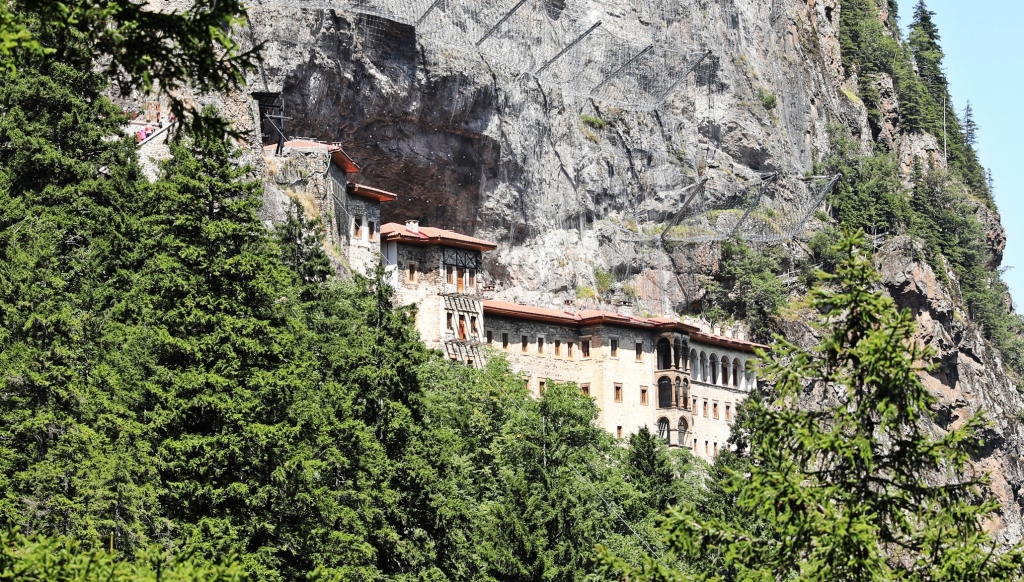
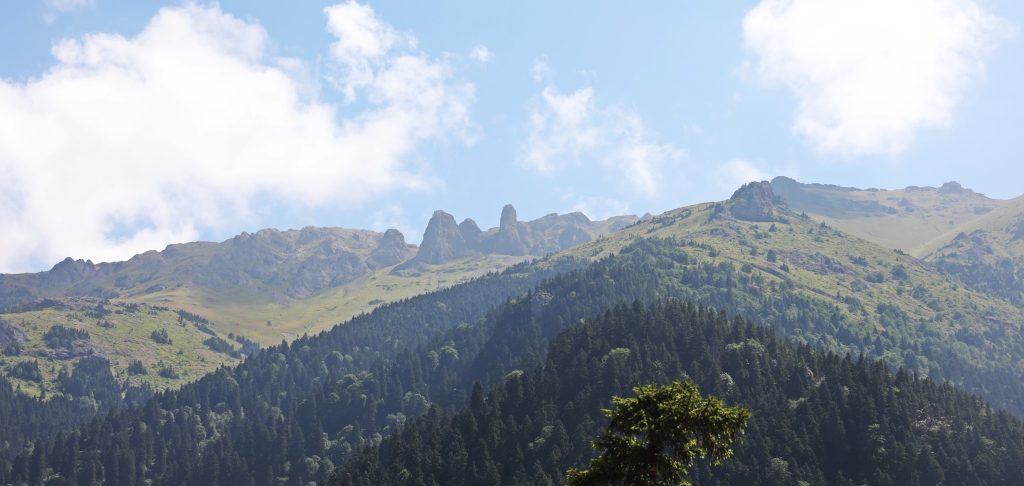
Today Sumela Monastery is a museum that showcases the wonders of architectural techniques that were used in this seemingly precarious spot. From the road below we stared up in awe at the sight of a stone building seemingly hanging off the side of the mountain. It seemed like the most unlikely place to build a monastery, but after reading the legend, we understood why.

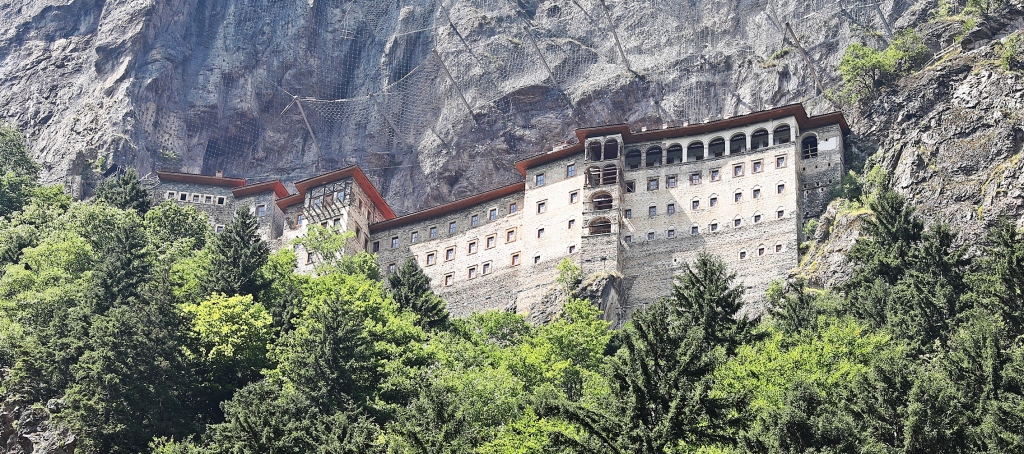
Once we reached the main entrance, we could see the ancient aqueduct that brought water to the monastery. A small staircase near by lead up to a platform above the monastery. From this platform we could see the church walls emerging from the cave. In front of it, dozens of stone buildings were crowded together on the ledge.
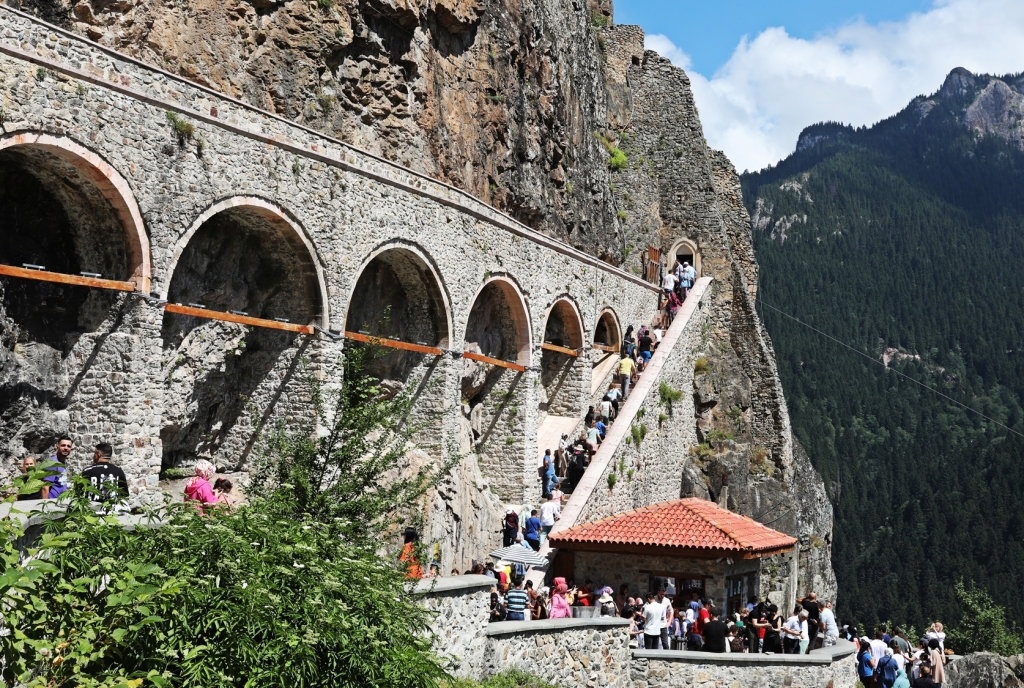
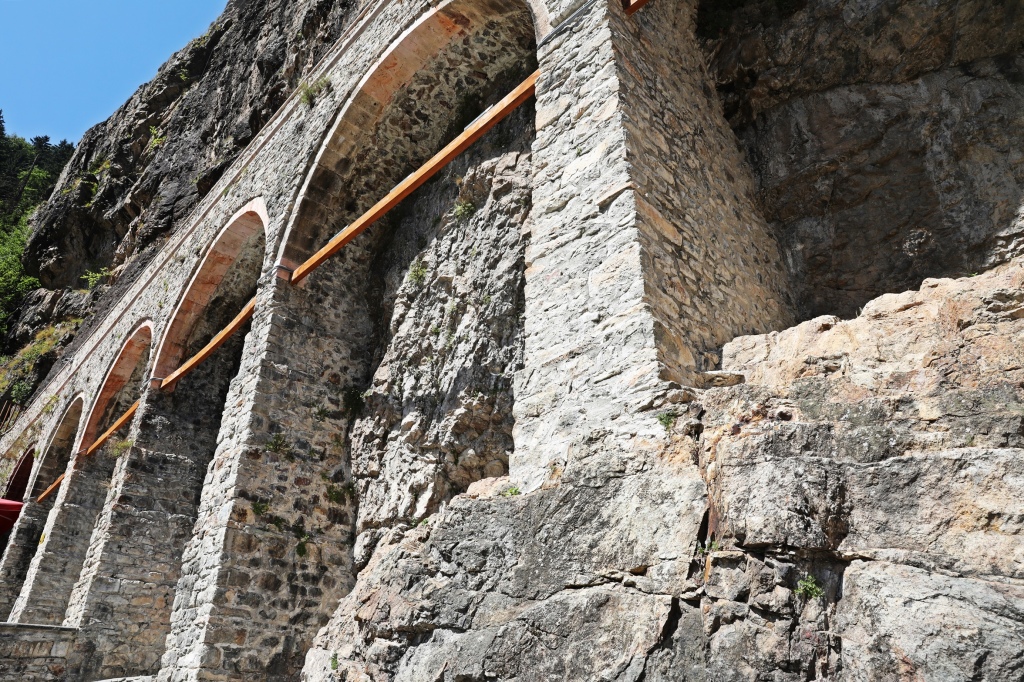

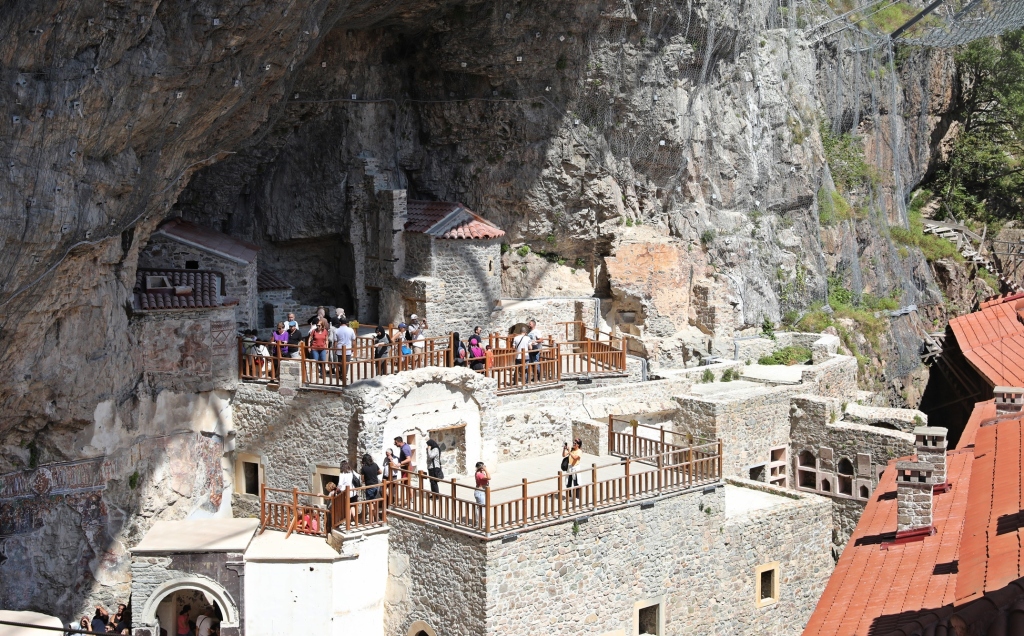
We walked down a steep set of stone steps to reach the main monastery floor. Surrounded by the tall exterior walls of the monastery made you forget that you’re standing on the edge of the cliff.
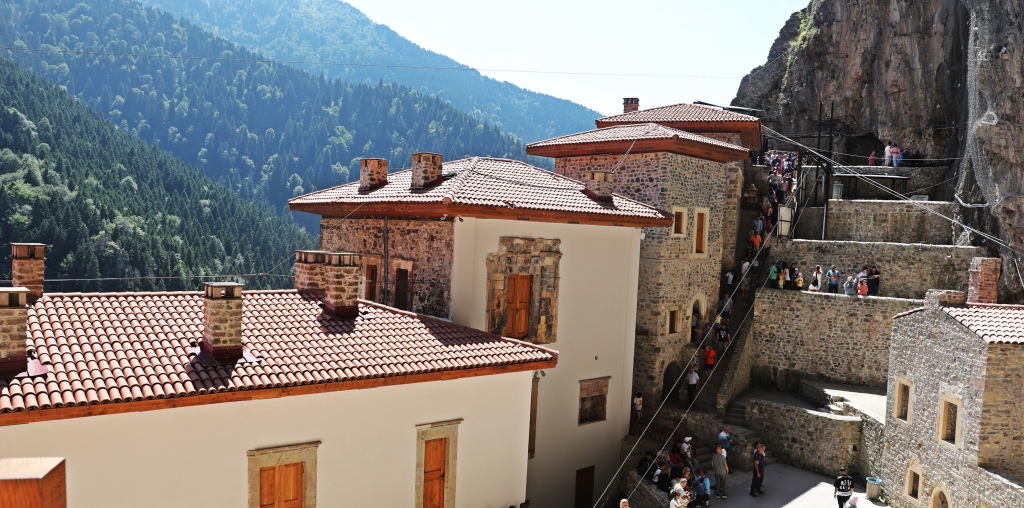
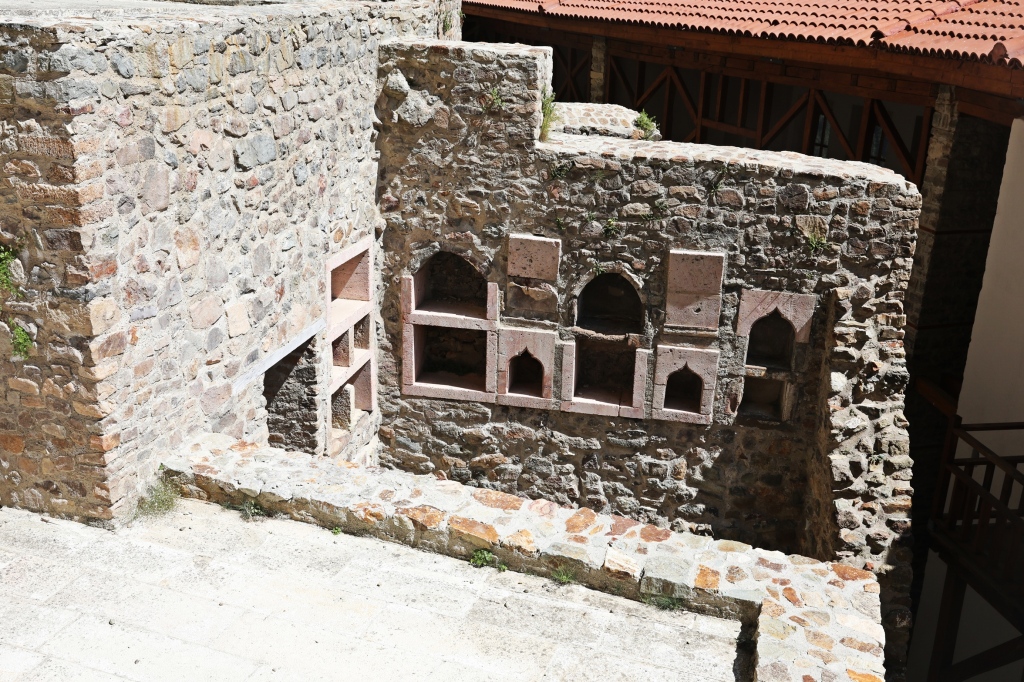
We walked along small hallways and up and down stone steps to get between different areas of the monastery. We visited the monks’ cells, a kitchen and library but most of the rooms were very bare with only stone walls and dirt floors. A few signs indicate how they were once used, but it would have been nice to have simple furniture set up to make the rooms more relatable.
The highlight of the cave is the main rock chapel that was built deep inside the cave. The rear of the church is made from the walls of the cave. Its outer walls were built of stone and bricks. Both outside and in, the church’s walls are decorated with beautiful 14th century frescos. We stood staring at them in awe, trying to imagine how it would have looked hundreds of years ago. Some have been worn by weather and unfortunately, many by vandalism. There were enough frescoes in good condition to understand their brilliance.
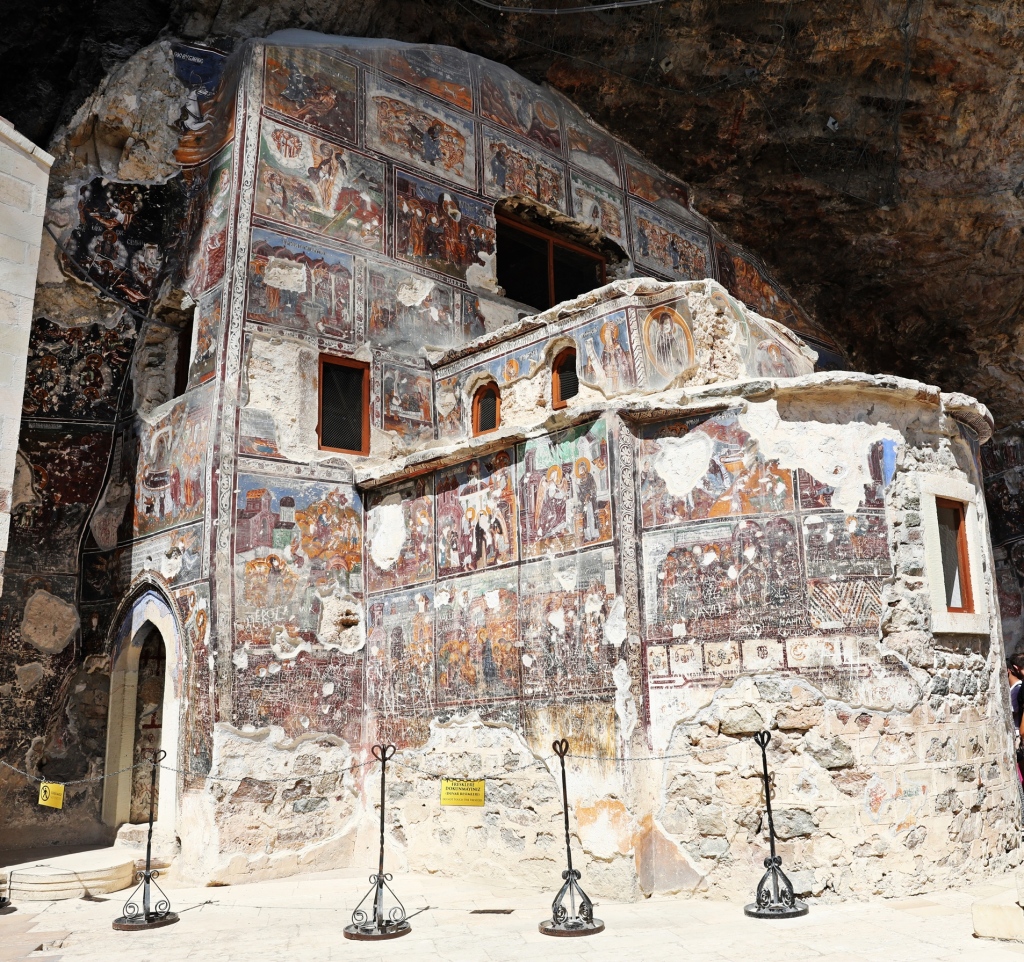
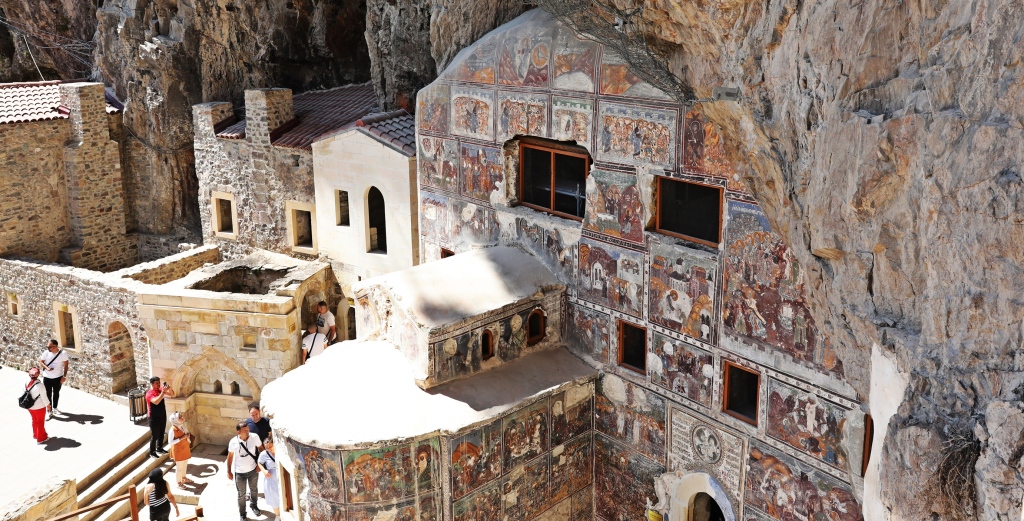
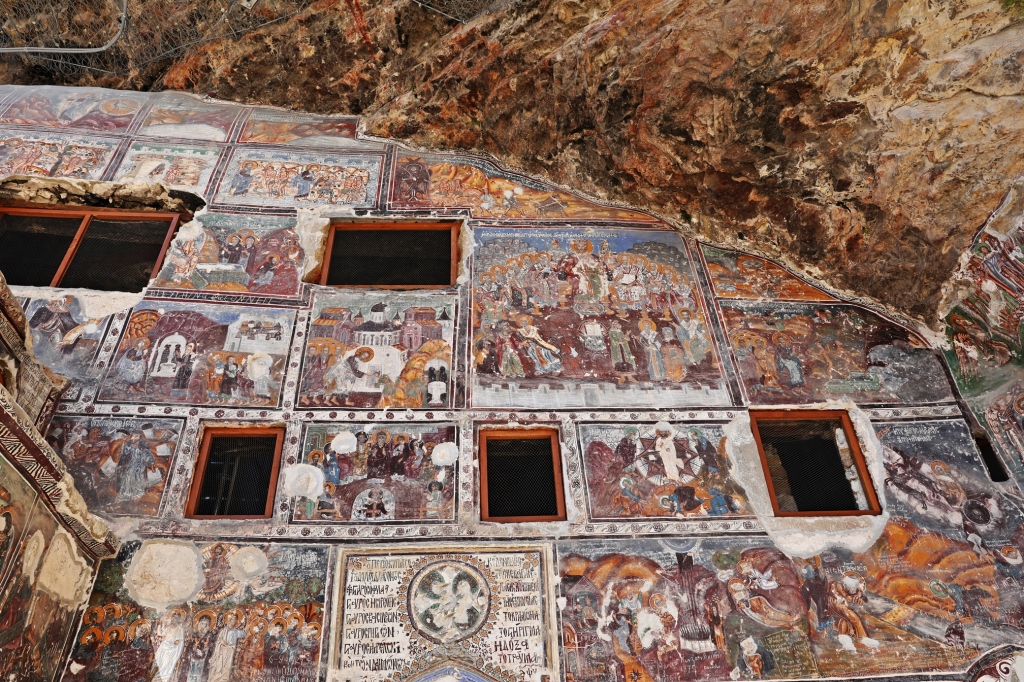
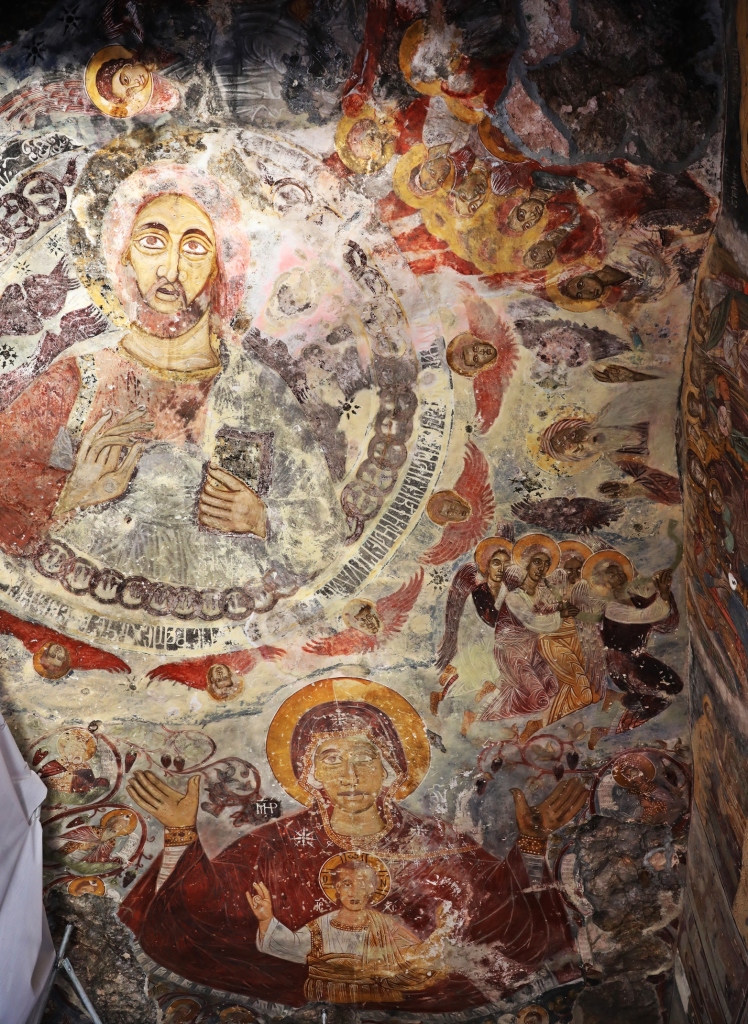
Below the cave is a small chapel Aya Vavara Kilisesi that offered another great view of this picturesque monastery.
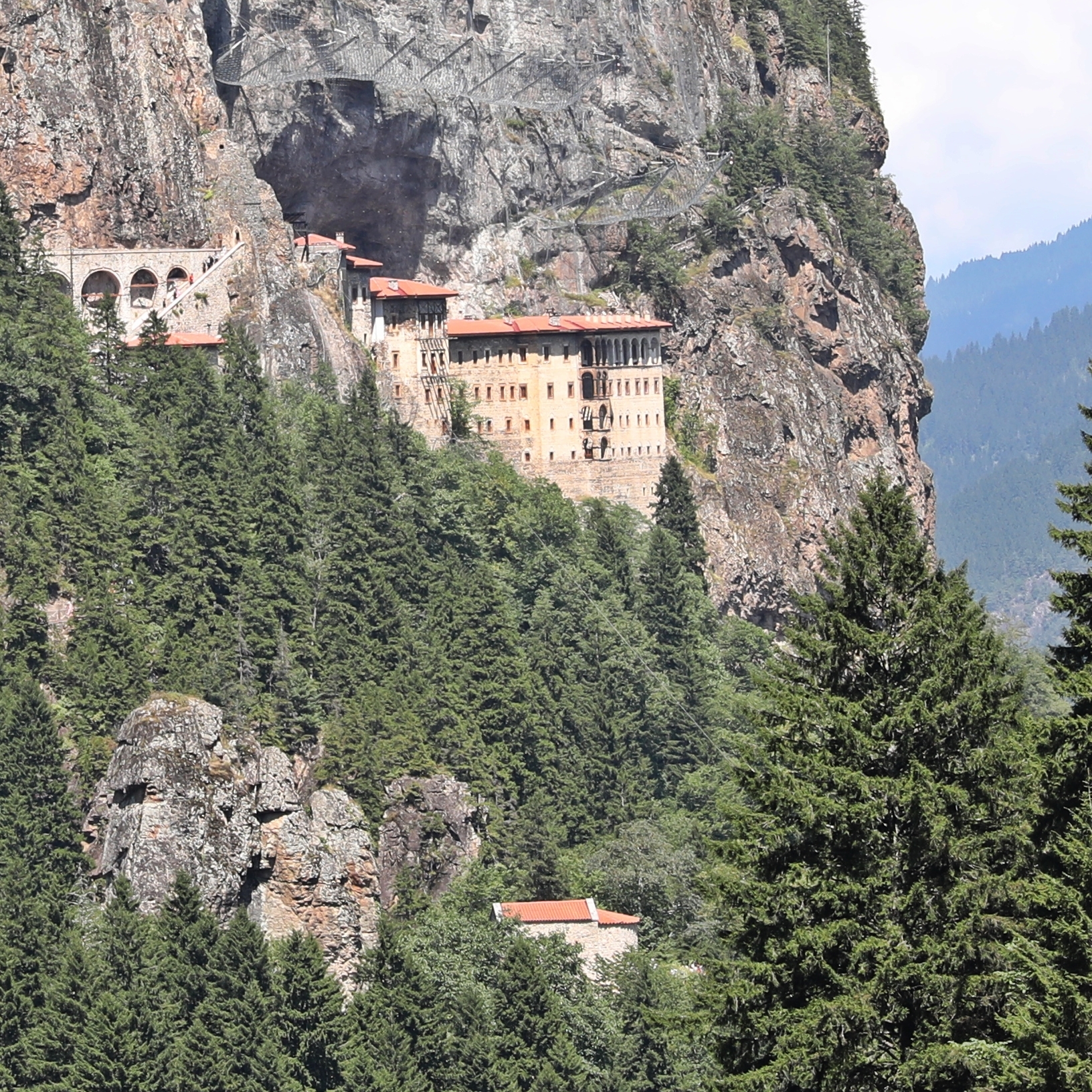
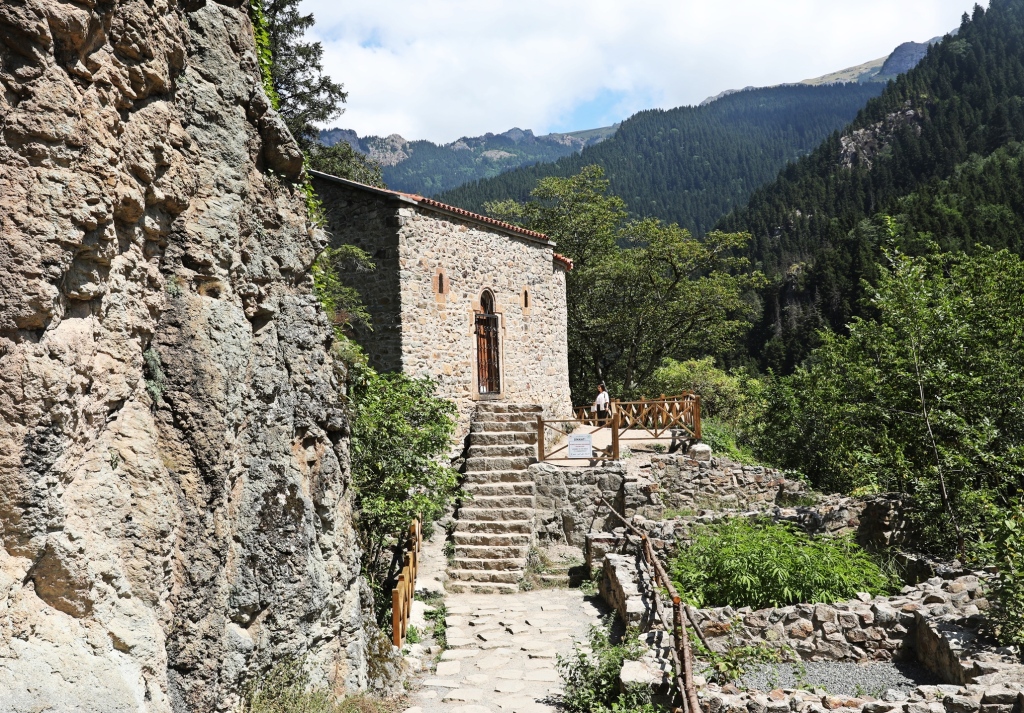
Entry fee – In 2023 the fee was 450 TRY ($16 USD) for foreigners. In addition you can not drive up to the monastery, Shuttles run from the parking lot below and cost 40 TRY ($1.40 USD).
Getting to Sumela Monastery
The easiest way to see the monastery and other nearby sites is by car or with a tour. We used Sumela Tours located in Trabzon. You can reach it on your own by bus from Meydon (City Center) in Trabzon.
After visiting the monastery, we stopped at a few other sites of interest in the nearby mountains.
Karaca Cave
The mountains around the monastery are very lush with thick forests, but we hadn’t driven far away when the landscape dramatically changed. In the Zigana Mountains, the land is much more arid with only a few bushes scattered on the hills. We stopped at a lookout for a view and the California-like mountains.

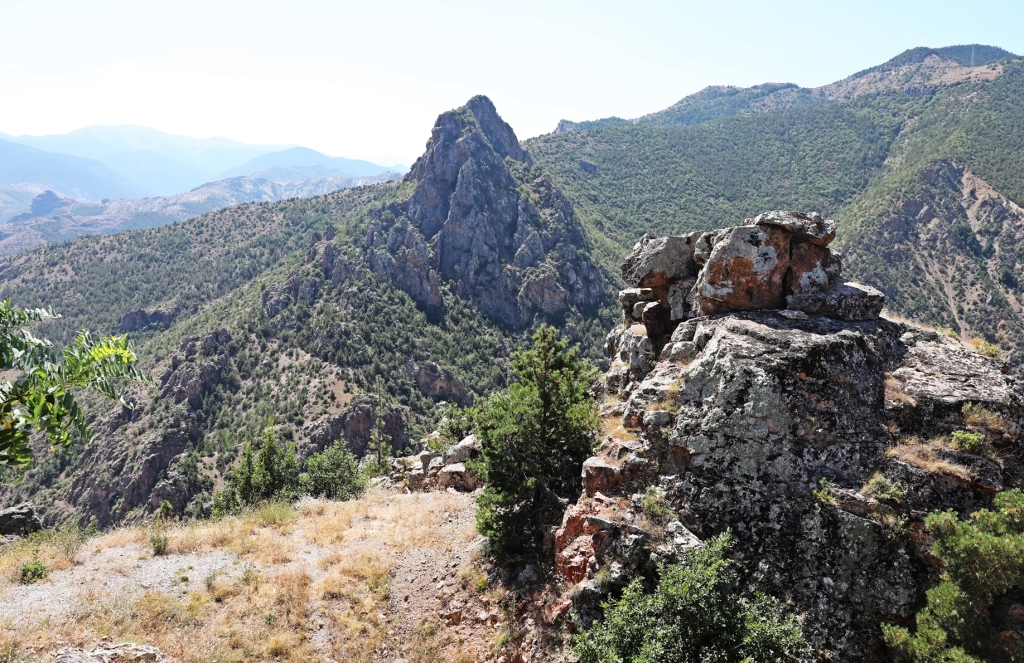
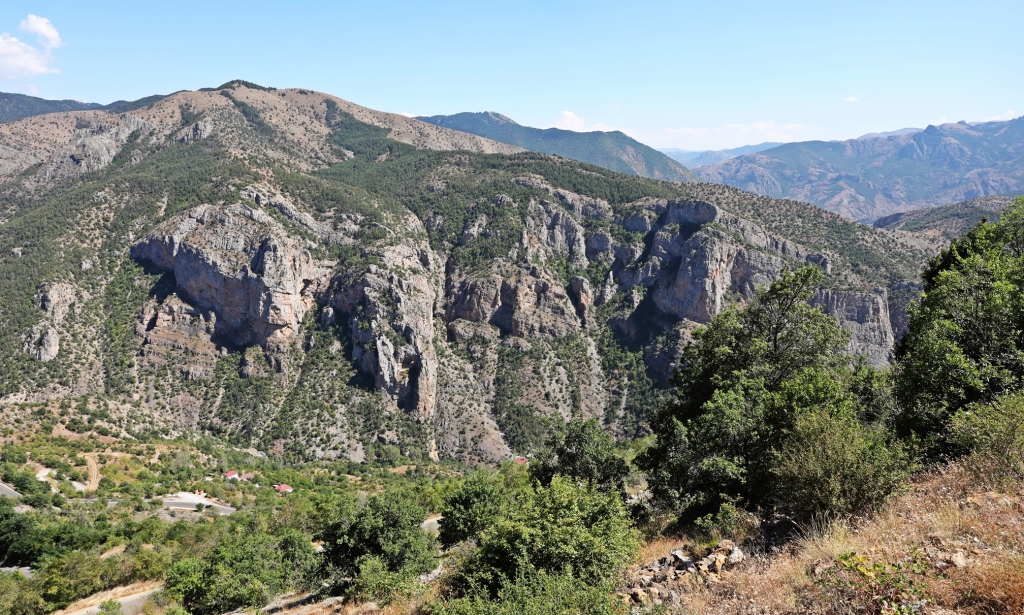
Hidden in these arid mountains is an interesting cave. We’ve been to a lot of caves and although not overly large, we thought Karaca Cave was worth the trip. Once we stepped inside the cave it had the feeling of being crowded. But it wasn’t crowded with people, instead there were copious amounts of stalactites and stalagmites that gave it that feeling. It was the shear number of them that makes this cave an interesting site. A good metal pathway that takes you between the pillars as you walk through the different caverns.
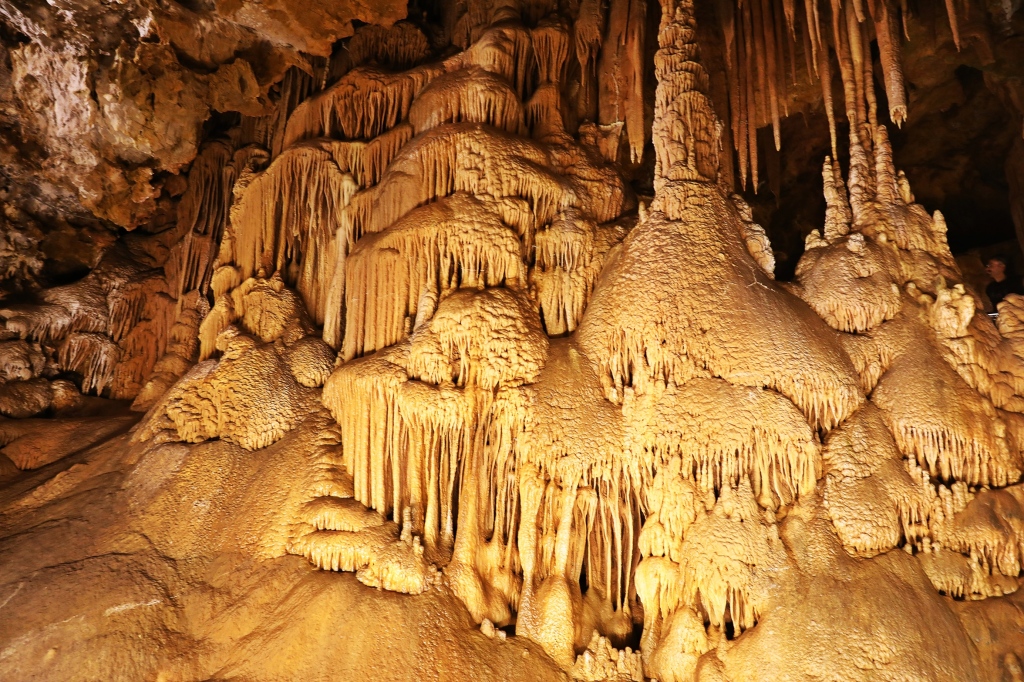
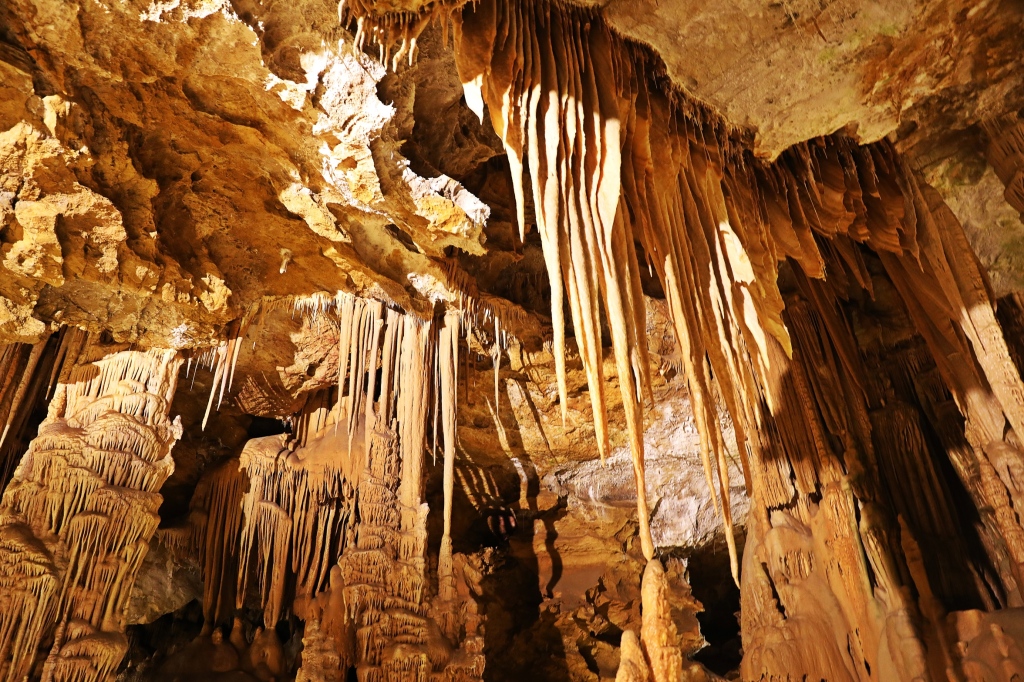
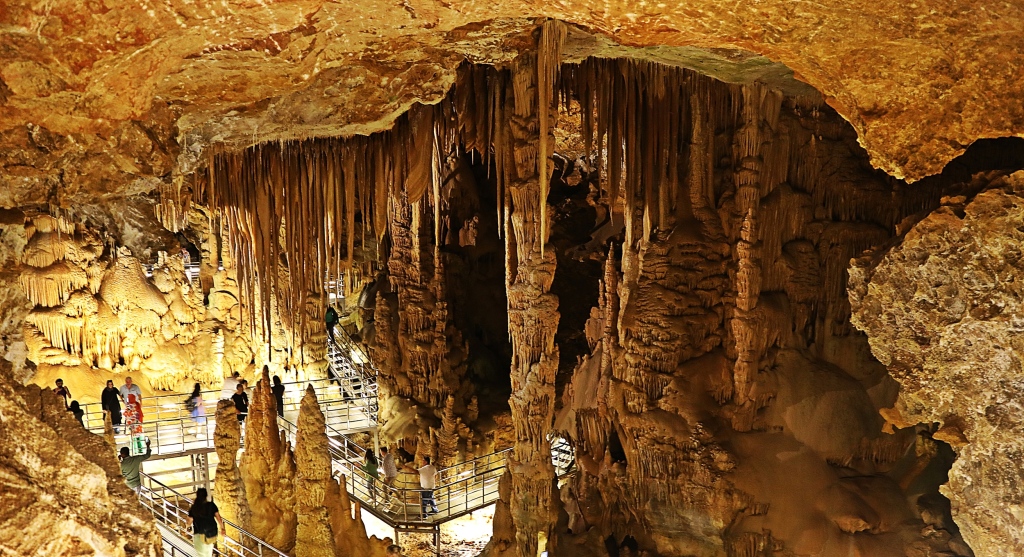
A sign at the entrance said ‘If the power goes out, don’t panic, it will be stored in 30 minutes.’ That seems like an awfully long time to stand in the dark in a cave. Luckily for us there was no power failure.
Hamsikoy Village
On the way back to Trabzon we stopped in the adorable village of Hamsikoy. It is famous in the area for its rice pudding and most people on our tour had some. It didn’t look or sound at all appetizing to us so instead of eating pudding, we went for a walk to get a better glimpse of this idyllic little town.
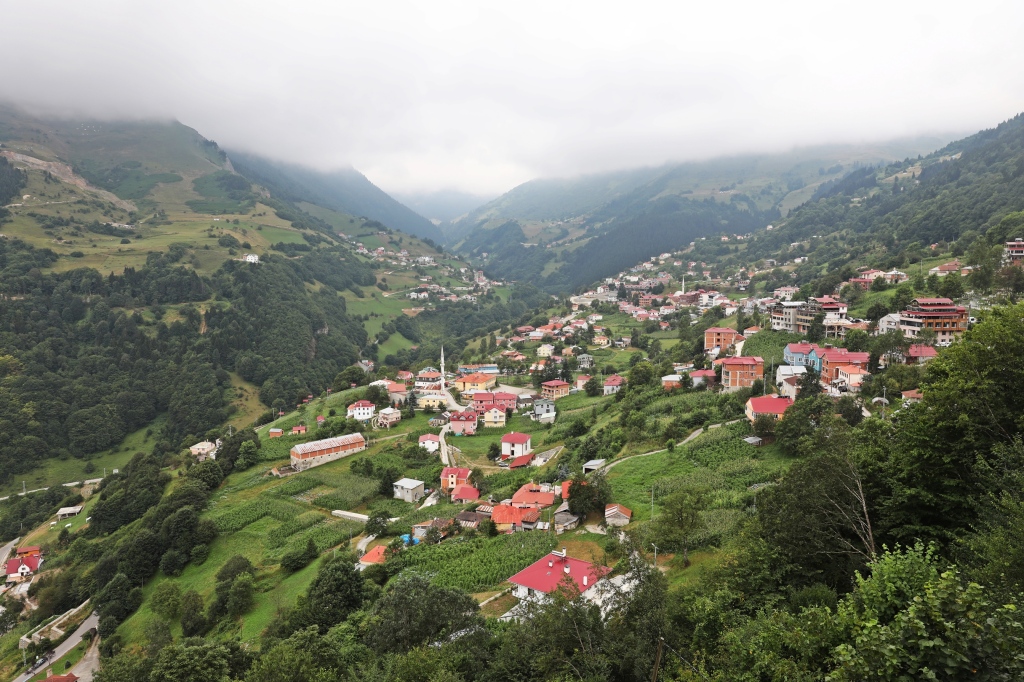
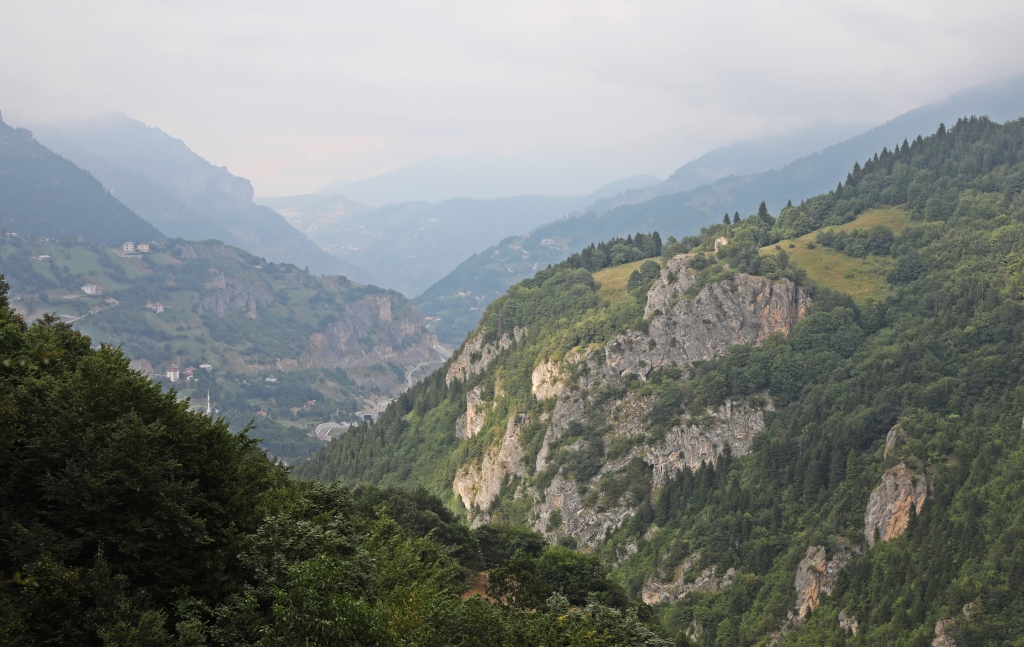
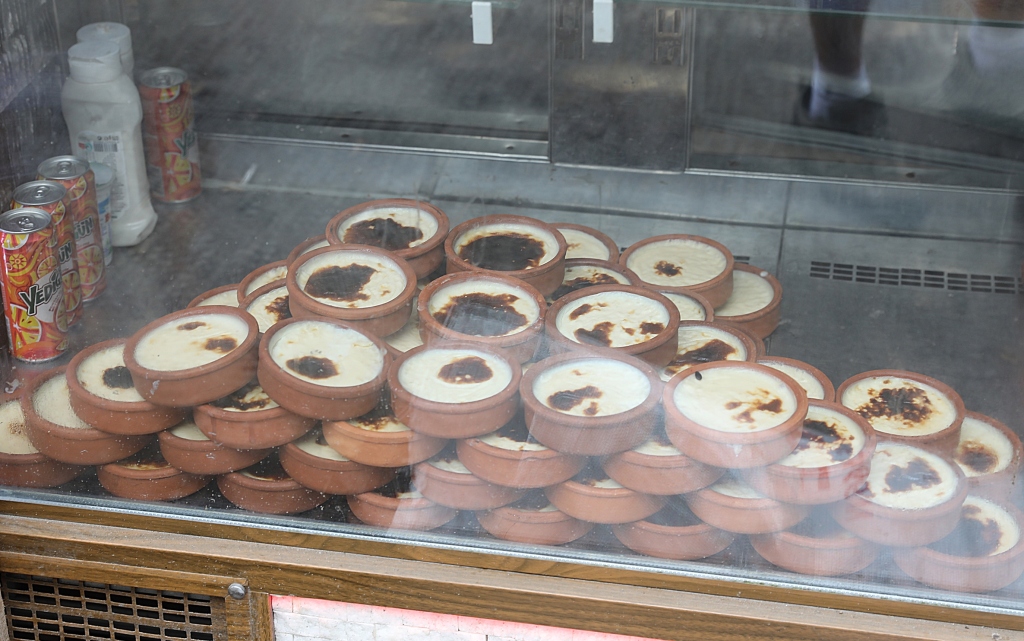
Trabzon
The best city to access Sumela Monastery is Trabzon. It is a large city that climbs up and down small, steep hills on the edge of the Black Sea. There’s not a lot for the traveller to see, but we did happen to find a couple of sites of interest in town.
Hazelnuts
In every shop, market or street corner there were dozens of vendors selling hazelnuts. Many of the hazelnuts used to make products like Nutella come from Turkey.
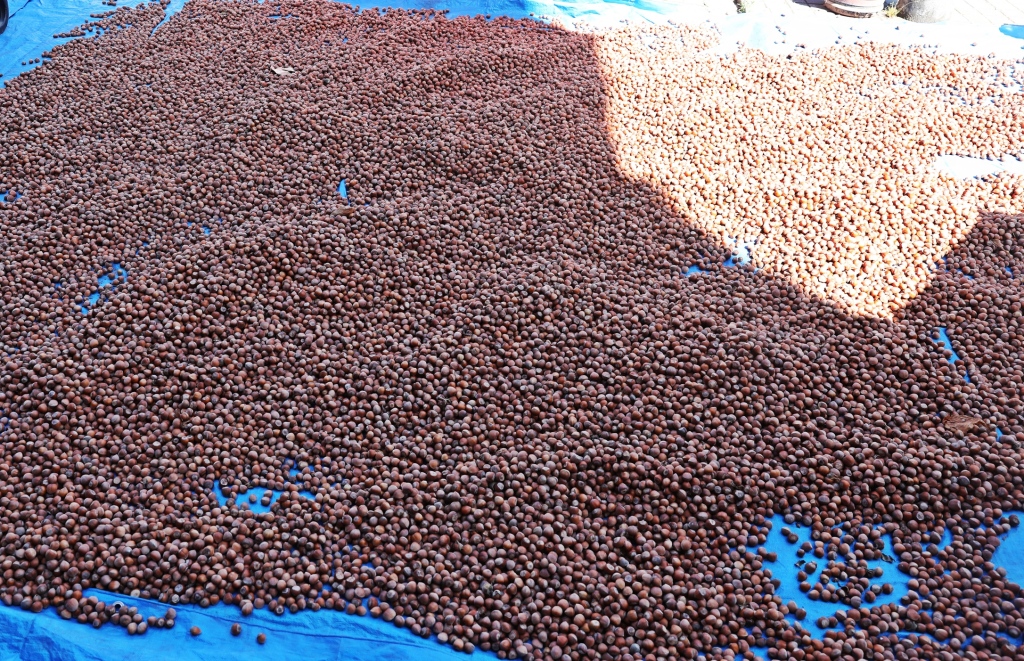
Hagia Sophia
Same name, different location. Hagia Sophia in Trabzon is a lovely 13th century building on a small hill. It has a gorgeous location set right beside the Black Sea.
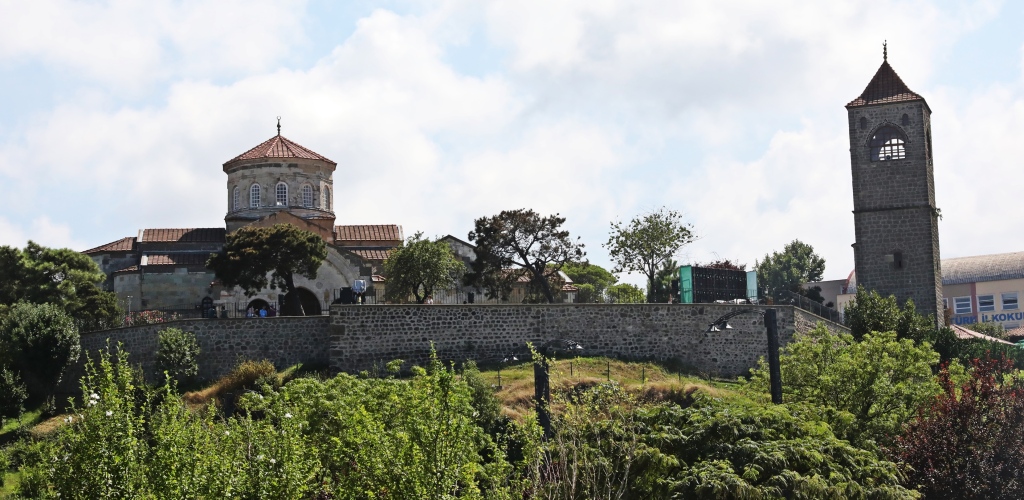
Built as a church by Byzantine rulers, its stone brick walls don’t give it the glamour of other historical churches, but it certainly has its own charm. The cross-shaped design under a single domed roof make it simple but pretty building. At its side is a bell tower also dates to the 13th century. In a region prone to earthquakes, it is one of the oldest towers still standing.
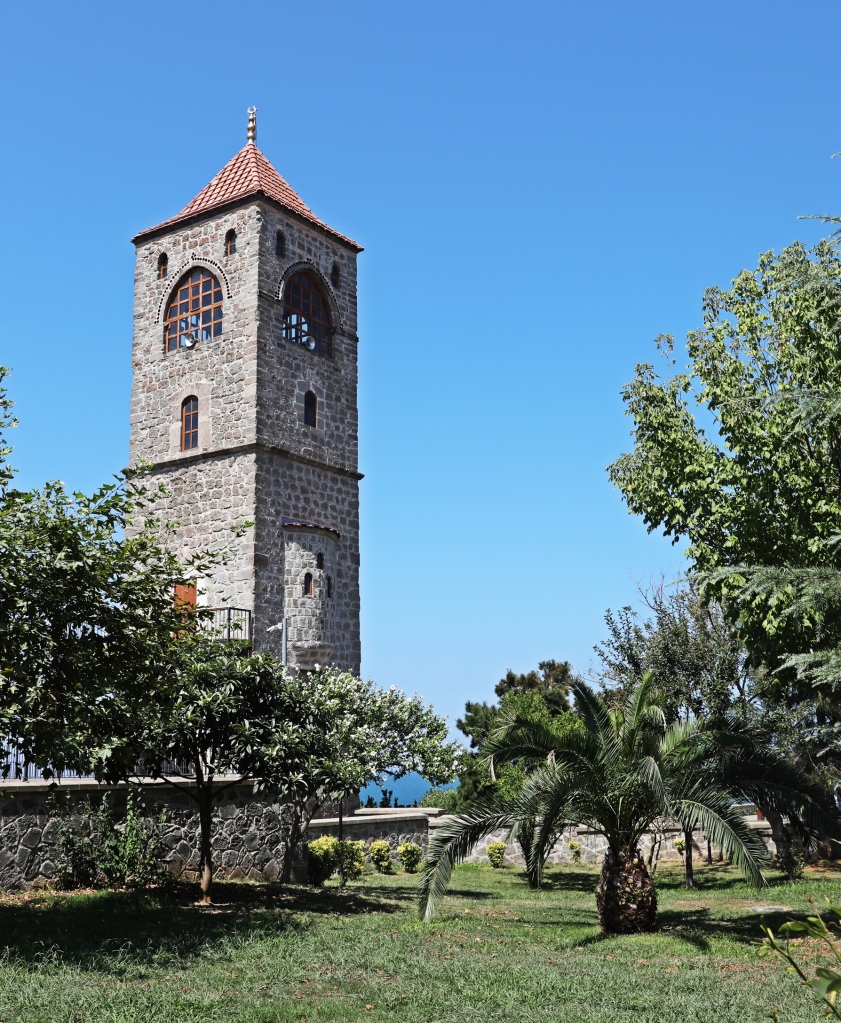
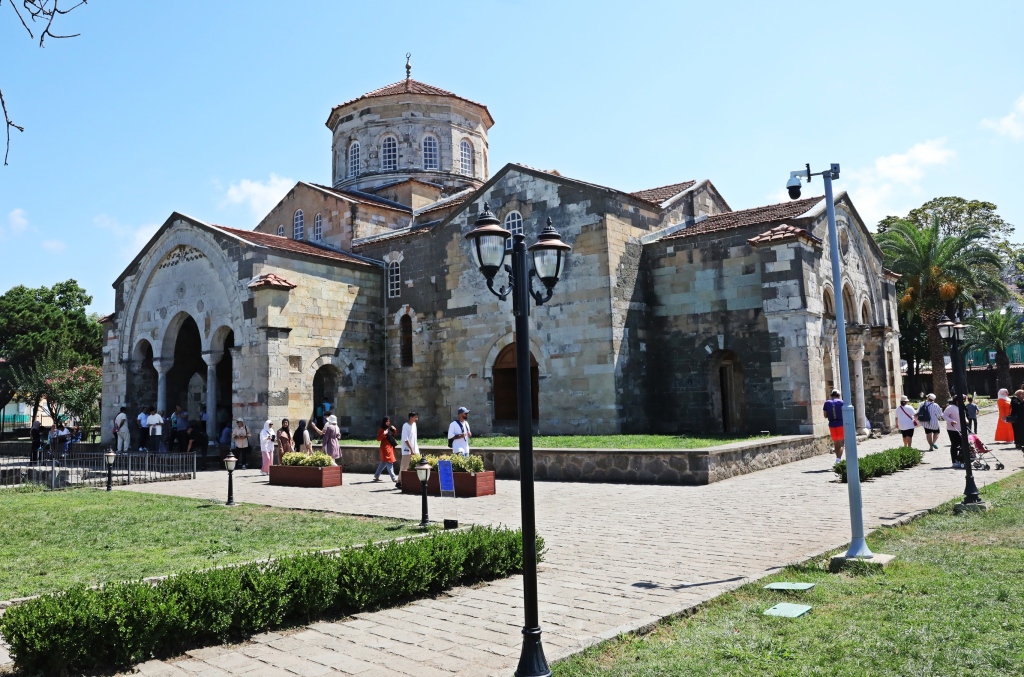
The stone ceilings and arches of the south nave are decorated with centuries old frescoes depicting scenes of Adam and Eve, heaven, saints and angels. A side naves has wonderful frescoes that have been left uncovered including one of Jesus.
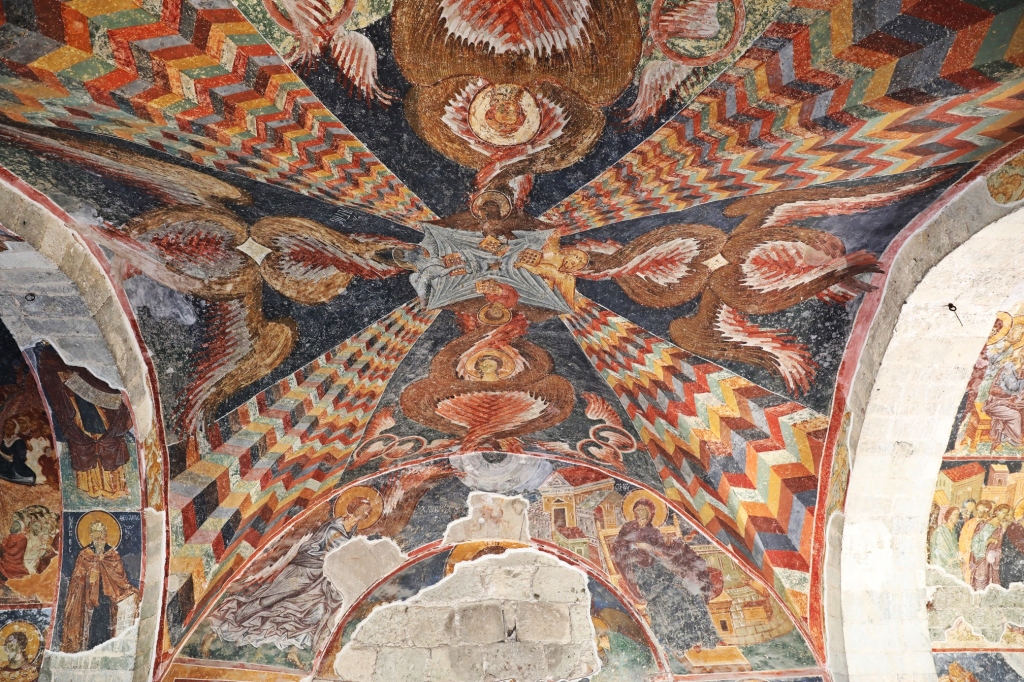
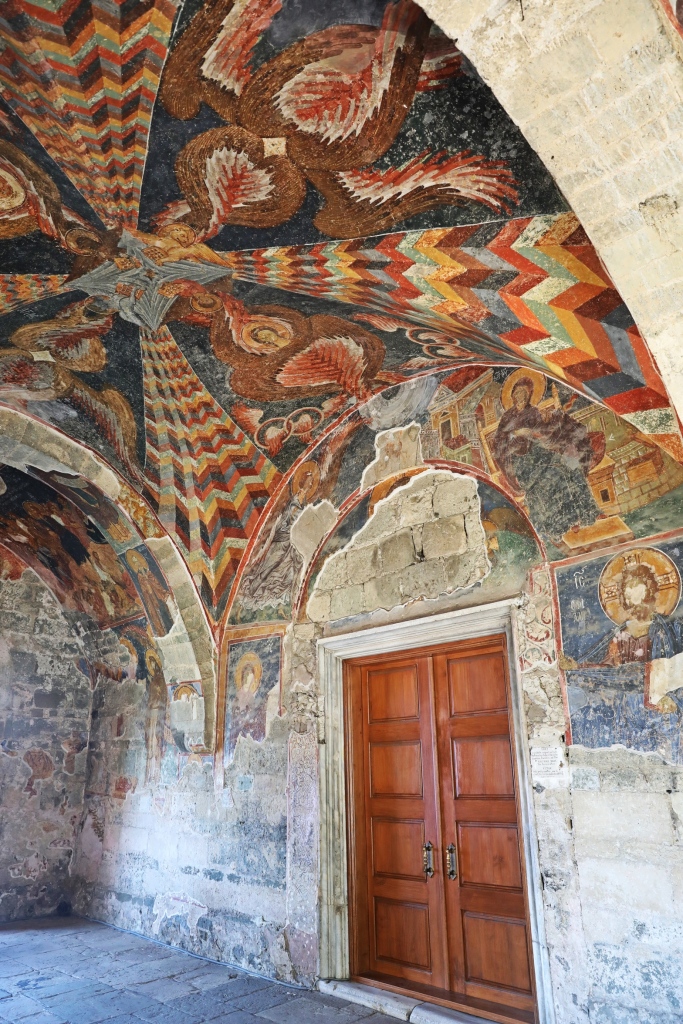
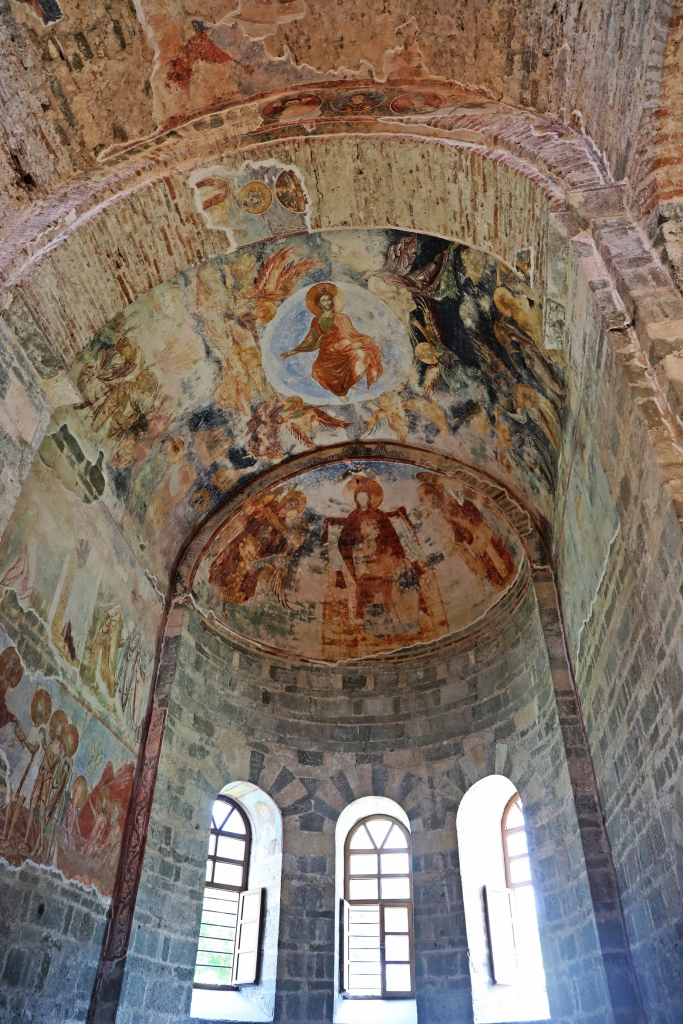
On the ceiling of the main sanctuary are a few more Byzantine frescoes. The centre dome however has been covered and we were unable to find out what the paintings depict under them. Something really special in this building is beneath your feet. The original floor has been covered in glass allowing you to see the detailed masonry that once covered it all.
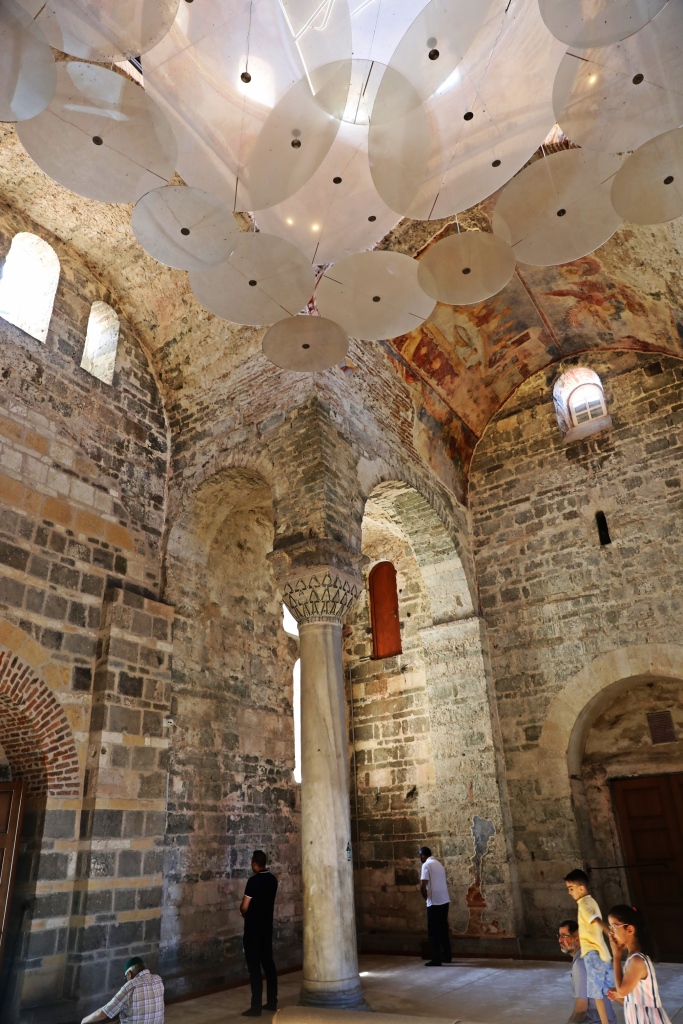
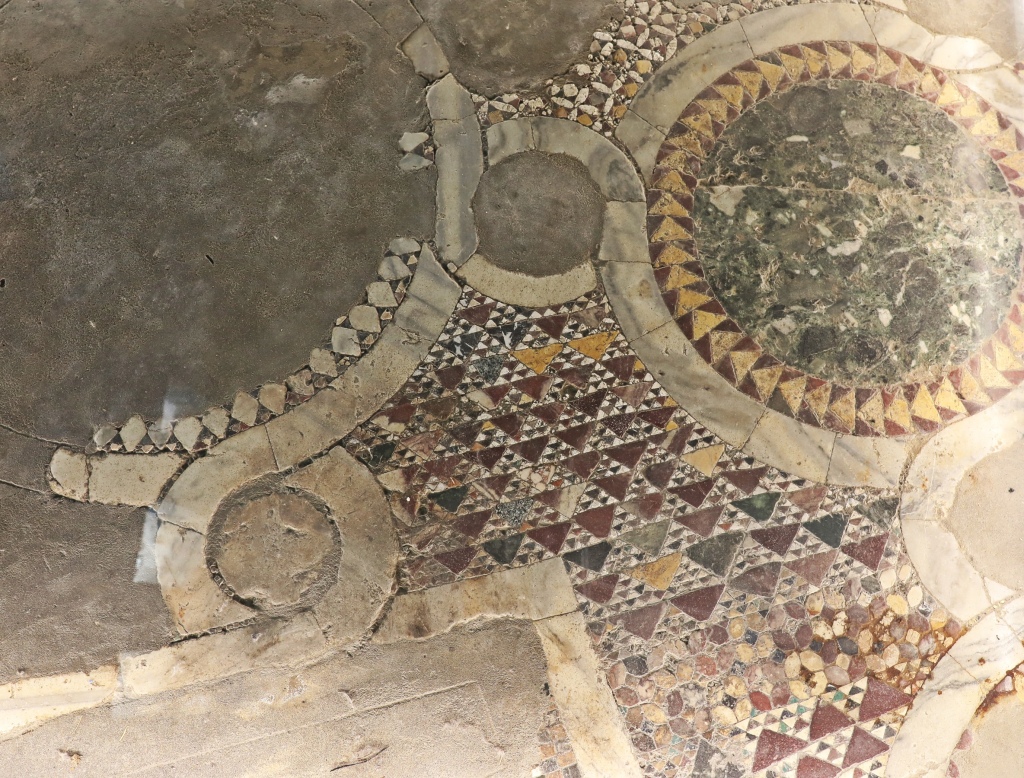
The church was converted to a mosque in 1461 when the Ottomans conquered Trabzon. For a short period of time Russian Czars ruled this area and used this beautiful building for different purposes. First they used it to store armory and then as an army hospital. In the 1960s it was restored and opened as a museum. Later it was also re-allocated as a mosque as well as museum.
Kızlar Monastery
Up on the top of a steep hill in Trabzon is another historic Christian site. Also known as Panagia Theoskepastos Monastery, it is more commonly called Kizlar Monastery. The name translates in English to Girls’ Monastery.
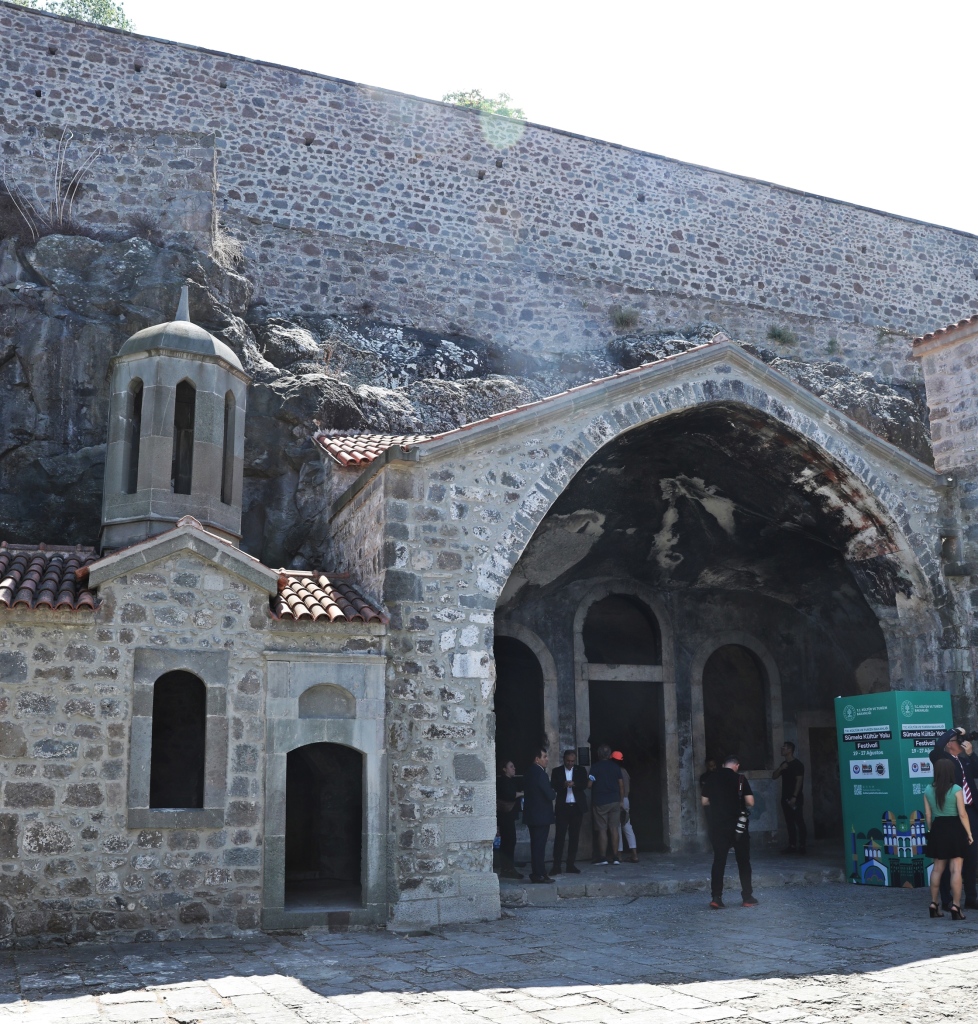
Built during the 14th century by the Empire of Trebizond, the monastery is small having a couple of chapels and seven nun cells. Each cell has a large window that opens up to an amazing view of the Black Sea. Today, the views also include the city of Trabzon.
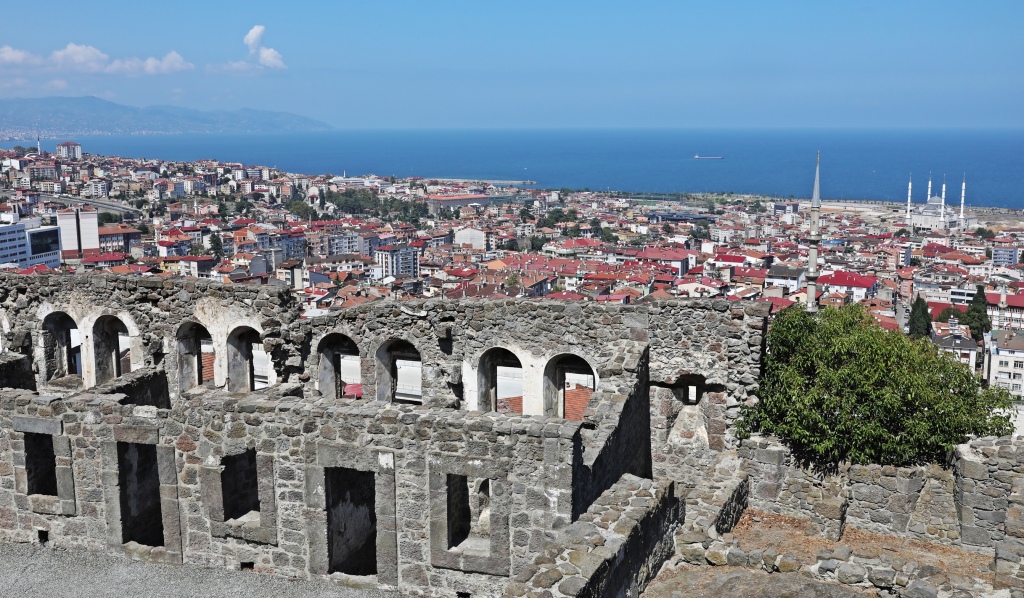
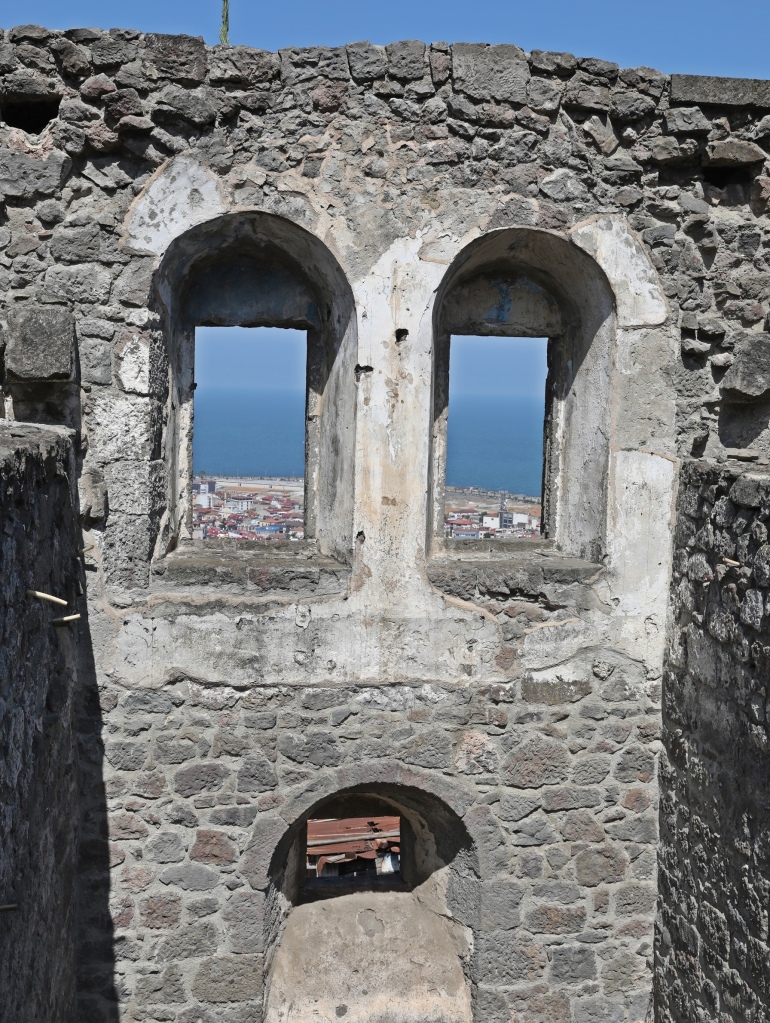
Trabzon Castle
In the middle of the hilly city, are the former defensive walls originally built by the Romans. There apparently never was an actual castle in Trabzon, but the walls are usually referred to as such. Part of the wall was in quite good condition, but a lot is in ruin.
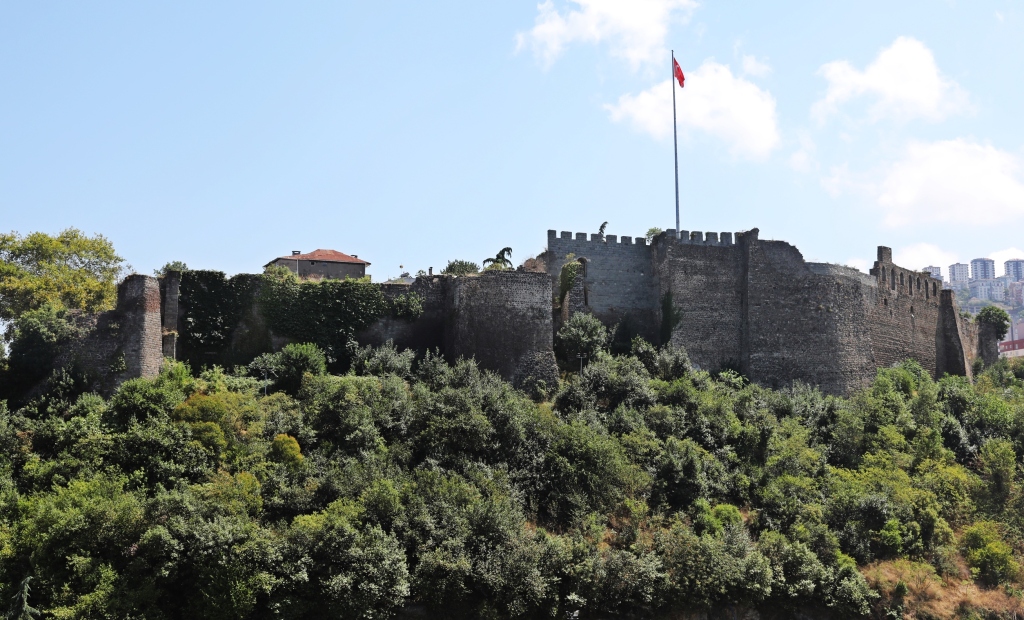
Beaches
Situated along the Black Sea you would expect sandy beaches everywhere. There are a few beaches east of town, but most of them, including the one in town are pebble beaches with black sand.
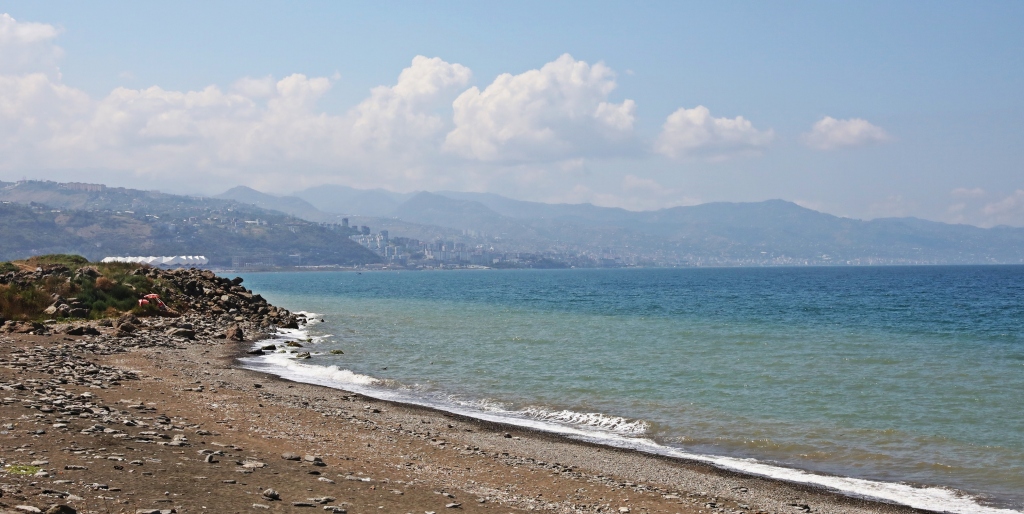
Although there isn’t a lot to do, Trabzon is a pleasant place to stay when visiting Sumela Monastery.
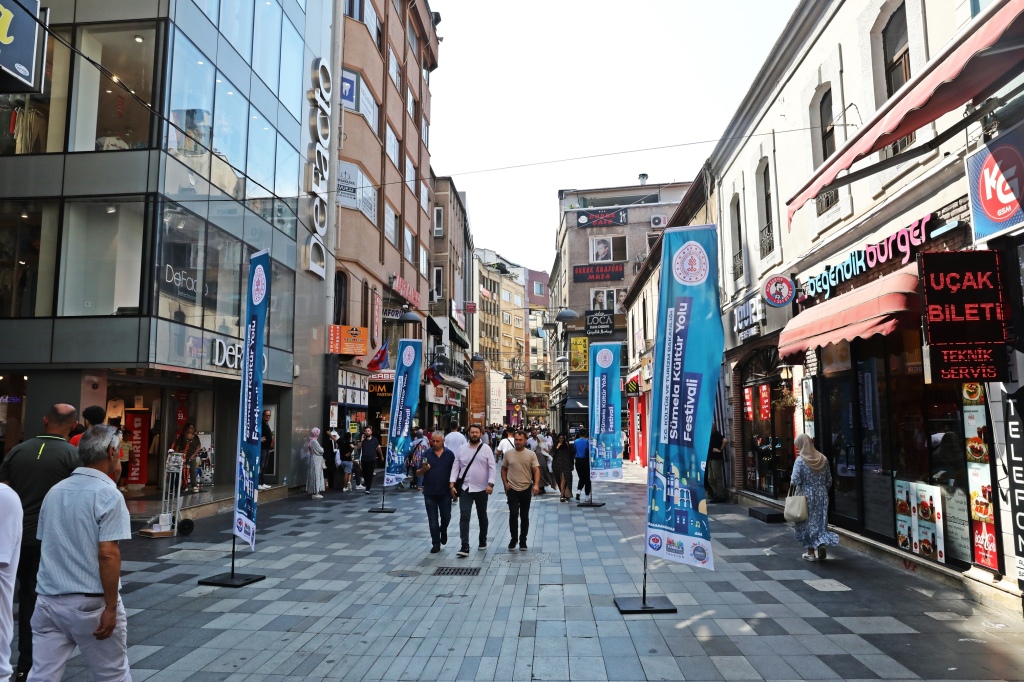

Click on the link to read more of our posts from Turkey.
Coming Next – Seljuk Dynasty in Erzurum, Turkey
For pictures from other blogs go to Gallery at monkeystale.ca
To read about more of our adventures go to Destinations.
If you like what you read, please comment or share (with credit) using the links below.
We have a church like this not far from Verona. It literally clings on the side of a mountain. The legend says that angels brought it there. 😊
Thanks for sharing this breathtaking place.
LikeLiked by 1 person
These monasteries show such devotion both in their precarious location and the elaborate paintings. I’d love to see the one in Verona.
LikeLiked by 1 person
So many incredible sights! It blows my mind thinking of how they could build that monastery, pretty amazing.
LikeLiked by 1 person
I know, it must have been quite the undertaking.
LikeLike
Pittoresque et grandiose
LikeLiked by 1 person
😊
LikeLike
Perhaps not a valid comparison yet the monastery and church remind me of some of the Indian dwellings in the southwest U.S..
LikeLiked by 1 person
I had the same thought!
LikeLiked by 1 person
I haven’t seen them on person, but they probably do have some similarities to other cave dwellings.
LikeLiked by 1 person
The construction materials are very different. The overall looks are similar.
LikeLiked by 1 person
I mean I haven’t seen the ones in the US
LikeLiked by 1 person
Wonderful essay and photos. As for the monastery at the edge of a cliff: How in the world did people construct it? Incredible.
LikeLiked by 1 person
I know, it’s pretty incredible to see what they could build without any modern tools.
LikeLiked by 1 person
Wow. I love the monastery! I’m always so amazed at the dwellings that are just built into the face of a cliff like that. It make sense, though, since the back half wouldn’t need to be built. I can imagine that amounts to hundreds if not thousands of hours of labor that is saved. The frescoes add a nice pop of color to it as well.
LikeLiked by 1 person
It is amazing to see what and where they built these amazing churches isn’t it?! 😊
LikeLike
That monastery is incredible! What a place for refection and peace surrounded by those mountains. The frescos in the monastery and church are stunning- I always love when works of art like this survive the times and the elements and remain so beautifully intact. 🙂
LikeLiked by 1 person
It s incredible to see this artwork that is centuries old. Some was damaged by graffiti. I really can’t understand why anyone would do that whether it’s your faith or not. But quite a lot has survived and is amazing to see. 😊
LikeLiked by 1 person
The monastery is phenomenal as is the Hagia Sophia. It’s difficult to fathom the skills, tools, and building materials they needed.
LikeLike
The setting of that monastery is stunning, as are the frescoes of the rock chapel, however damaged and worn. I also really like the ones on Hagia Sophia in Trabzon, the colours are so rich!
LikeLiked by 1 person
We really only stopped by Hagia Sophia because of the name, but wow what gorgeous frescoes and mosaic floors.
LikeLiked by 1 person
Wow! So much amazingly interesting history in that part of the world. On a modern note, we need the Virgin Mary to save a few rich people and tell them to build houses for those in need.
LikeLiked by 1 person
Haha yes wouldn’t that be nice 😊
LikeLiked by 1 person
Thanks for the tour of these beautiful sites!
LikeLiked by 1 person
Thanks Rebecca, there are so many stunning places to visit in Turkey. Thanks for your comments. Maggie
LikeLiked by 1 person
The monastery is absolutely amazing. We’re hoping to visit Turkey in a few years and will add this location to our itinerary. Are there a lot of steps to thoroughly tour the facility? There are so many other interesting places to see in the area too. Terrific photos as well. Thanks Maggie!
LikeLiked by 1 person
i am impressed by all of the posts. the writing is excellent & brings it alive; good advice is give for harmonious interaction; good places to eat & sleep are given too. this is my very favorite travel blog! it’s the “adventure” that brings it alive!🚀🚀🚀❤️❤️❤️
LikeLiked by 1 person
Thank you so much I really appreciate your kind words. Maghie
LikeLiked by 1 person
Fantastic photos, Maggie. So unfortunate that war lead to the abandonment of the monastery and its subsequent deterioration (including vandalism).
I don’t like rice pudding at all either, so would have also gone for a walk! Nutella is a different story, though. 🙂
LikeLike
What an impressive monastery. I couldn’t help think of all the labour that must have been involved in building the structures.
LikeLiked by 1 person
It’s quite remarkable to think how they were able to build such an impressive building high up on a mountain cliff isn’t it l?!
LikeLiked by 1 person
Definitely
LikeLike
What an amazing region. I love the mosaic tiles (think I may have mentioned that in another post).
It’s fascinating how ancient buildings are built into a cliff face but also stunning. I’m mesmerised by this feat of engineering. Italy has quite a few.
Thank you for sharing this great tour!
LikeLiked by 1 person
These buildings are remarkable aren’t they.?! Both in their design but also in the decorations. We weren’t even planning on visiting Hagia Sophia in Trabzon but that mosaic floor was incredible!
LikeLiked by 1 person
Oh my gosh Maggie, that Sumela Monastery seems like it is gravitationally impossible where it stands. How beautiful and so intriguing! Love your photos my friend! 📸💖🤗
LikeLiked by 1 person
Good description Kym! It is quite the amazing building!! Maggie
LikeLiked by 1 person
🥰💖😍
LikeLike
Amazing to see so many people on that mountain, Maggie. What a location! Both scenery and frescoes are fabulous.
LikeLiked by 1 person
It is a pretty spectacular site! Thanks Jo! Maggie
LikeLiked by 1 person
Spectacular photos. It must have been incredibly difficult to construct that monastery up on that hillside back then.
LikeLiked by 1 person
I can’t even imagine how they were able to build it back then. We knew it would be interesting to see up on the cliff, but the frescoes wrote a great surprise.
LikeLiked by 1 person
There are a number of monasteries in precarious cliff side positions like this and they’re all fabulous to visit, just to wonder at the devotion and determination that drove their creators to complete the project. And there is almost always a story….divine guidance, location of an icon or the seeing of a vision, which drove construction in the first place. You’re still in a part of Turkey which we haven’t seen but there is so, so much of the country which is worth visiting.
LikeLiked by 1 person
I think it is the devotion that amazes me the most. To build something way up there but also to make it so beautiful. We really enjoyed Eastern it is Turkey so much different from the southwest.
LikeLiked by 1 person
I love the look of the monastery. A true thing if beauty and an engineering feat! Thanks for the inspiration. Mel
LikeLiked by 1 person
It is both of those 😊
LikeLiked by 1 person
You folks post some of the most amazing places. This one is another gem!
LikeLiked by 1 person
It is a gem and not very often visited by non-Turkish tourists. 😊
LikeLike
Gorgeous tiles.
LikeLiked by 1 person
They are! 😊
LikeLiked by 1 person
What an amazing place. Thanks for all the pics and info. 😊
LikeLiked by 1 person
It is quite spectacular, Thanks Pepper 😊 Maggie
LikeLiked by 1 person
Fantastic. Thanks for sharing.
LikeLiked by 1 person
Thank you John 😊 Maggie
LikeLike
Ever since reading “The Towers of Trebizond” years ago I have wanted to visit! Ill now have to note that amazing monastery which I didn’t know about and go visit when I do eventually get there one day!
LikeLiked by 1 person
I’ll have to look for the book. Sumela Monastery is quite fascinating. Trabzon wouldn’t be worth it if you only visited the city, but the monastery is more than worth it. 😊
LikeLiked by 1 person
I’m impressed by these monasteries clinging to the cliffs. A skilful combination of elevation to God and impregnable places, for history has not been kind around them.
LikeLiked by 1 person
Very true, there were so many empires, religious battles and unrest in these places but at least they left these amazing buildings.
LikeLiked by 1 person
All of this looks fabulous but that monastery is something else! Kinda reminds me of that one in Bhutan – the Tiger’s Nest.
LikeLiked by 1 person
Well it’s not as spectacular as Tiger’s Nest, but it was an amazing site. We didn’t even know about the frescoes on the church inside, they made it even better.
LikeLiked by 1 person
Awesome pics and it defines how beautiful these places are.. Specially the monastery.
LikeLiked by 1 person
Thank you so much, this monastery was such a treat to see 😊
LikeLiked by 1 person
Ah, this is spectacular, especially the tiny Monastery and the Rock church. There are similar rock churches in Romania too 🙂
Thank you!
LikeLiked by 1 person
We went to Romania after visiting Turkey and the artwork is very similar. We only saw one rock church when we were there but it wasn’t in very good condition. I can imagine that it once looked like this. Thanks Patricia. Maggie
LikeLike
A fantastic monument to true grit and faith to build in stone and then up the side of a mountain! Amazing!! Sumela Monastery is amazing beyond words. I did not expect such ordered structures on the site and the ornate paintings, reliefs, and artwork. Truly a wonder! Your photos were so unique, the angels and views from the monastery are fantastic. Odd to see the arid land crop up just a short distance away from Sumela Monastery.
Love the market scene with the nuts for sale. Always fun to see markets.
Hagia Sophia has such a great history. I like that door you featured! It does not seem as old as Hagia Sophia itself. The wood of the door seems to be a more modern design.
LikeLiked by 1 person
I’m not positive but I think that door is newer, but certainly the stone frame around it would be original. We also had no idea that there would be so many incredible frescoes inside Sumela’s Rock Church. It was a wonderful surprise.
LikeLiked by 1 person
Oh that makes sense, the door may be a replacement. Sumela Rock Church is fantastic! Thank you!
LikeLiked by 1 person
Amazing, Maggie ! Thank you !
LikeLiked by 1 person
Wow, I don’t know where to start. How on earth did they build it in to the cliff face like that, it’s incredible…and those views…and the frescoes….and then the cave and the village and the churches. What a place. It feels so ancient and magical and I can only imagine seeing it in real life feels even more so.
LikeLiked by 1 person
I know it’s incredible to think they built something up so high, but then to also make it so beautiful! It was a little magical. 😊
LikeLike
It seems like in a lot of parts of the world, many ancient people shared something in common: they found high places very sacred, as shown by the plethora of religious monuments built on mountains or on cliffsides. It’s amazing to think of the amount of time spent on constructing those, and the ingenuity to overcome the challenges. I really appreciate you giving us a tour on Trabzon. I’m particularly intrigued by its own Hagia Sophia.
LikeLiked by 1 person
It really is consistent theme, closer to the gods I guess. We didn’t even plan to visit Hagia Sophia but based on the name we decided we should. It is a remarkable building with the Byzantine artwork and mosaic flooring, I’m glad we went.
LikeLiked by 1 person
It’s amazing enough to see building like that nearly glued to a cliffside. But then add in the idea there were no power tools back in the day when they built it, and it becomes even more impressive.
LikeLiked by 1 person
No kidding, not even a decent ladder to get things up there!
LikeLiked by 1 person
Sumela Monastery is amazing!
Alison
LikeLiked by 1 person
It is!! 😊
LikeLiked by 1 person
What an incredibly scenic spot to build a monastery. It’s amazing how many of the frescoes inside the cave in the chapel have been preserved. The formations in the Karaca Cave are stunning.
LikeLiked by 2 people
We knew the view of the monastery on the cliffs would be spectacular but didn’t realize that the inside of it would be equally stunning. It was a great site to explore. Thanks Linda! Maggie
LikeLiked by 1 person
👌🏻📷👍🏻. 👏🏻👏🏻👏🏻👏🏻👏🏻
LikeLiked by 1 person
Thank you!!
LikeLiked by 1 person
Turkey has few of these remote beautiful monasteries, right? Amazing how those frescoes are still standing up, but a huge restoration would be more than welcome, if that would be so easy..
Happy Friday😊
LikeLiked by 1 person
If the restoration could be done properly then I’d say yes, but there’s also something about these ancient paintings in their current state that adds to the cave. Either way, it’s very impressive to see. 🙂 Maggie
LikeLiked by 1 person
This is fascinating. The pictures look amazing. Turkey sounds a wonderful travel destination.
LikeLiked by 1 person
We spent a couple of months in Turkey and were constantly amazed by the incredible diversity of the cities and towns as well as the historical sites.
LikeLiked by 1 person
Thanks for sharing these amazing images .That monastery was so special. Anita
LikeLiked by 1 person
Thanks Anita
LikeLike
Spectacular!
LikeLiked by 1 person
Thanks, it is a fantastic monastery! Maggie
LikeLiked by 1 person
The monastery is so dramatically vertical perched on the mountain. Wonderful how much of the artwork has survived.
LikeLiked by 1 person
We didn’t know about the artwork before going so it was a huge surprise. We thought seeing the monastery perched on the hill was reason enough, but the interior was also amazing.
LikeLiked by 1 person
I am amazed by the picturesque monastery and marked it immediately in my bucket list. I would love to see monasteries such as this in future travels.
LikeLiked by 1 person
It is a fascinating site! I hope you get to visit it one day 😊
LikeLiked by 1 person
It’s amazing how they built the monastery in the edge of the mountain. I have always wanted to visit Turkey. Your posts are only adding to that urge.
LikeLiked by 1 person
We had seen pictures of the monastery on the cliffs and knew we wanted to see it. We didn’t know how interesting it is inside too, so it was a really great trip.
LikeLike
Wow! Super cool!!
LikeLiked by 1 person
what is it with humans?? Temples, monasteries are often built up high in the most impossible places. No wonder such places become pilgrimage sites they are so hard to reach! And this looks brilliant!
LikeLiked by 1 person
I know! But I’m glad they did!!! 😊
LikeLike